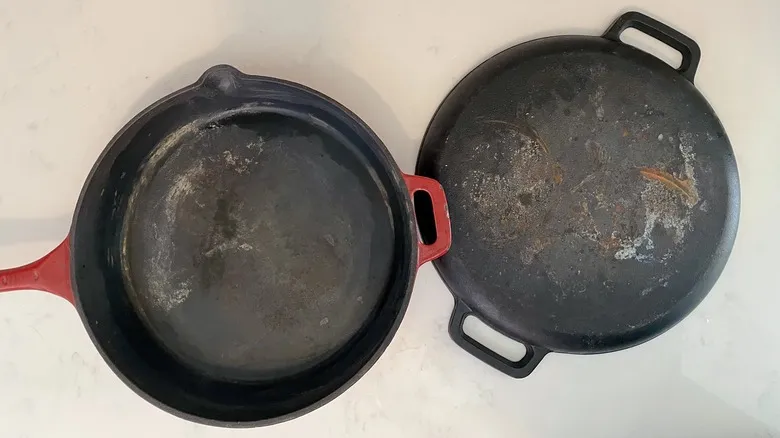What is seasoning?
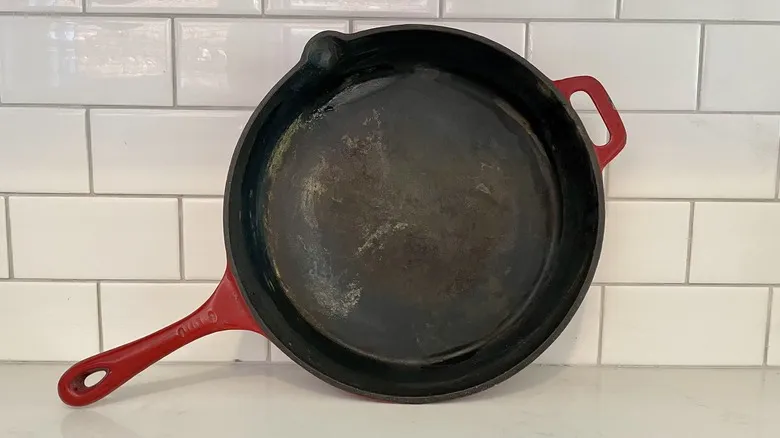
To begin with, it's important to understand what "seasoning" means. Seasoning is the process of applying a baked-on oil layer to a cast iron pan. When the oil is heated and baked onto the surface, it darkens and carbonizes, providing protection to the pan and forming the non-stick surface that cast iron is famous for.
Some cast iron pans come pre-seasoned, while others do not. You can determine if your pan requires seasoning by checking for rust and examining its color. A well-seasoned pan should have a rich black hue with a slight sheen. In contrast, a new, unseasoned pan will appear as shiny gray metal, while an older unseasoned cast iron pan may exhibit rust. Any unseasoned cast iron cookware must be seasoned before it can be used.
Over time, the seasoning will accumulate, but if a pan has been unused for an extended period or has been excessively cleaned, it may require a new layer of seasoning. This is particularly relevant for pans with exposed cast iron. Some cast iron cookware is either partially or fully enameled; for instance, the red pan shown above is enameled only on the exterior, meaning that only the exposed metal will need attention when it comes to seasoning.
What tools are needed

As previously stated, the process of seasoning cast iron is quite simple and doesn't require many materials. First and foremost, you'll need a pan that may need some care. Next, gather some dish soap and water. If your pan has any rust, you'll need either steel wool or a scrubber along with some coarse salt.
Lastly, you'll need oil. When seasoning, it's important to choose an oil with a high smoke point. The smoke point is the temperature at which the oil begins to burn and produce smoke. Our goal is to carbonize the oil, not trigger a smoke alarm, so avoid using olive oil, coconut oil, or butter.
We suggest using canola oil, which has a smoke point of at least 400°F. While many brands offer "reseasoning spray," these are usually just canola oil in a spray can, so you might as well save your money and use what you already have at home. You can also opt for grapeseed or sunflower oil, although they tend to be pricier. Choose whatever oil you feel most comfortable using.
Remove any rust
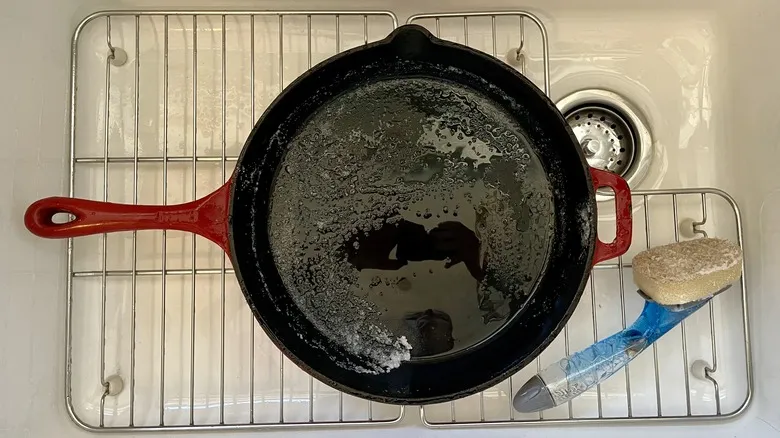
The initial step is to inspect your pan for any signs of rust. If you discover rust, it’s essential to eliminate it before moving forward. You have a couple of choices for this task: you can use some steel wool to scrub it off, or alternatively, you can use coarse salt along with a rough sponge.
The objective is to create a textured surface that will effectively remove the rust, revealing clean metal underneath. Whichever method you choose, continue scrubbing until all the rust is gone.
Clean with soap and water

Next, wash your pan using soap and water. Contrary to popular belief, it's perfectly fine to clean your cast iron with soap and water. Since we’re going to reseason it shortly, be sure to remove all debris and rinse thoroughly to eliminate any soap residue. Gently dry your pan afterward.
Coat in oil
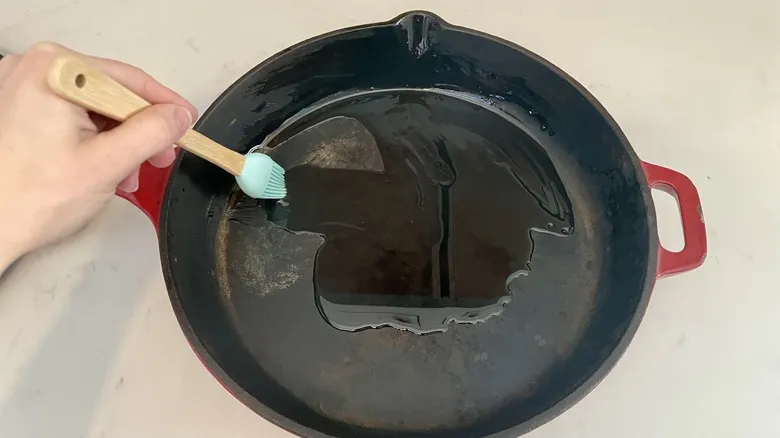
Apply a light, thin layer of oil to any exposed cast iron. If your pan has an enameled exterior, there's no need to oil that surface; just focus on the exposed iron. You can use a spray can to apply the oil, brush it on with a pastry brush, or simply wipe it on with a cloth or paper towel.
Bake in the oven

Once oiled, position the cast iron skillet upside down in the oven. This helps avoid oil from accumulating and creating an uneven or wavy seasoning layer. To catch any drips, place a baking tray lined with foil on the rack below your pan. Bake the cast iron at a minimum of 350°F, but ideally around 400°F for best results. Be aware that the baking oil may emit a strong and somewhat unpleasant odor, so it's advisable to open a window and turn on your vent hood if possible.
If you have access to a grill, consider using it for seasoning your cast iron instead of the oven. The grill can reach high temperatures and will prevent any unpleasant fumes from filling your home.
Rest your pan
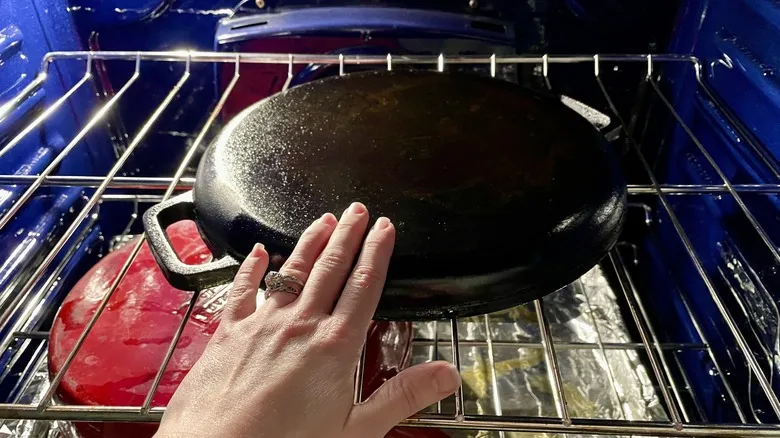
After one hour, switch off the oven and allow your pan to remain inside to cool. Repeat this process along with the previous step as many times as necessary to attain a glossy black finish. Generally, 1 to 3 layers should be adequate.
Wash and dry

Lastly, give your pan a final wash and dry before storing it. This time, you won’t need any soap. Ensure the pan is thoroughly dry before putting it away to avoid any further rust development.
Basic cast iron care
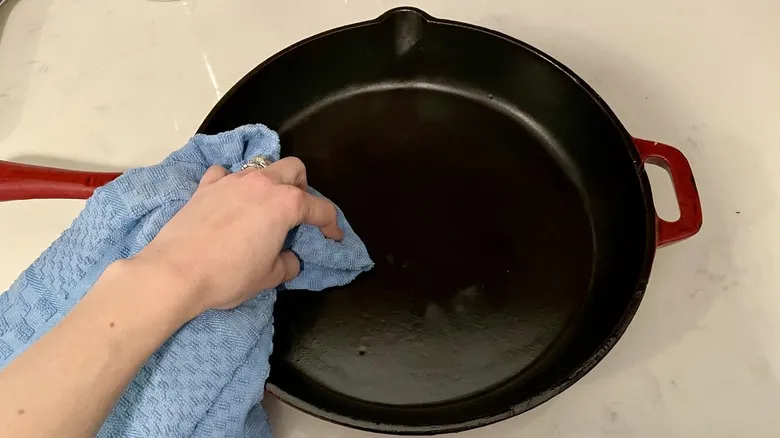
Now that your cast iron skillet has been beautifully restored, it's important to maintain it properly. You can wash cast iron pans after each use; using soap is acceptable, but avoid scrubbing too hard, as this can damage the newly restored seasoning.
Additionally, always keep your cast iron dry when it's not in use, as moisture can lead to rust. Be cautious with acidic foods like tomato sauce, as they can erode the seasoning and impart a metallic flavor to your dishes.
If you notice the seasoning becoming thin again, be sure to reseason as needed. However, with regular use and proper care, this should not be necessary.
Recipes to test your cast iron's new seasoning

Cast iron is remarkably adaptable. One of its key benefits is its ability to transition effortlessly from the stovetop to the oven. This feature makes it ideal for dishes like cast iron cornbread, as well as soups, stews, and baked chicken breasts. Additionally, you can use it to prepare a crispy Monte Cristo sandwich, buttermilk pancakes, or any other skillet dish.
Recommended

Are Metal Utensils Safe To Use On Cast Iron?
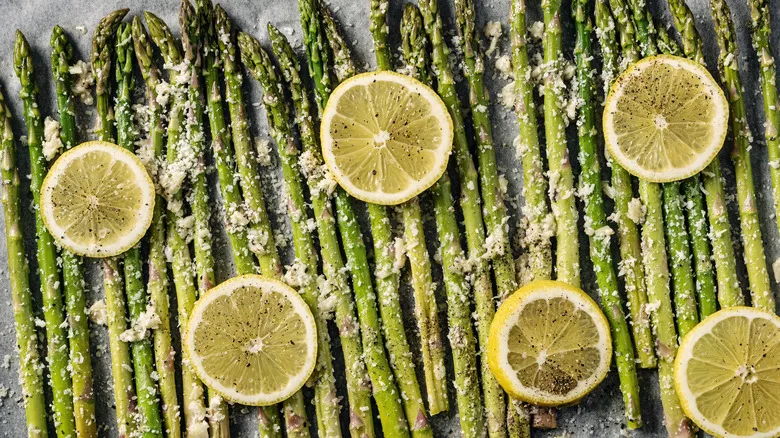
13 Mistakes Standing Between You And Perfect Asparagus

Turn Leftover Holiday Ham Into The Next Morning's Eggs Benedict

The Paper Bag Trick To Prevent Ice Cubes From Sticking Together
Next up

